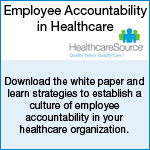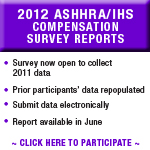ASHHRA eNews Pulse
ASHHRA
February 15, 2012Dear ASHHRA,
Over the last several weeks, I have heard at least three people use the term "servant leader." When Robert Greenleaf first coined this term he was placing people, someone other than himself, as his greater responsibility. Wikipedia states "A servant leader is someone who is servant first, who has responsibility to be in the world, and so he contributes to the well-being of people and community."1 This has been on my mind because Valentine’s Day is this month. This is the month where we celebrate our love for others. Typically this is our love for our spouse, children, parents, and even our brothers and sisters (believe it or not... I send them both a Valentine each year). What if this year, in addition to sending flowers and Valentine’s cards, we also celebrate love for others by volunteering in an organization where we can make a contribution?
What if this year, you also choose to celebrate your love for others by volunteering? Would you consider ASHHRA? You could join a team of amazing volunteers that are dedicated to sharing their love for others by being servant leaders in our human resource community. Debbie Ruebens, SPHR-CA, director, Human Resources, Shriners Hospitals for Children, Northern California, Sacramento, Calif., leads the Learning and Education Committee. Her team works all year to anticipate our needs and provide webinars that help us stay informed and ahead of potential problems. Nancy Dinon, vice president of HR, Orlando Health, Orlando, Fla., and her committee are responsible for the annual conference. This conference provides more than education; it provides an opportunity to network, which is essential to our success. Mike Paruta, associate vice president, Women and Infants Hospital, Providence, R.I., the chair of our Advocacy Committee, leads a committee that charters a course for us in Congress. They advocate throughout the year for change that will benefit all of our employees and organizations. As you read these articles throughout the year, you will learn about other ASHHRA committees and task forces that are also contributing to the well-being of people and community. Along with the board, all of these individuals are exemplifying servant leadership.
Although we are beyond the new year, will you consider making a new year’s resolution? Call it your Valentine’s Day Volunteering Resolution. The possibilities are endless. You can volunteer by participating in a walk/run. You can take a senior out to lunch or teach a young person to read. You can introduce someone to the joys of the outdoors and bird watching (I admit, this is one of my volunteer goals for this year.) There is no limit to the contribution that you can make to people and your community. As you are thinking about this, think about ASHHRA. Think about sharing your love of health care with others in our profession by serving on a committee. Complete the online Volunteer Interest Form
Leading People Through Change,
Irma L. Pye, SPHR
ASHHRA 2012 President
Senior Vice President & CHRO
Valley Baptist Health System
Harlingen, Texas
1Servant leadership. (2012, February 2). In Wikipedia, The Free Encyclopedia. Retrieved 20:34, February 7, 2012, from http://en.wikipedia.org/wiki/Servant_leadership
Visit http://www.snapsurveys.com/swh/surveylogin.asp?k=132767389517 to view the full article online.
Visit http://www.ashhra.org/publications/compensation_survey.shtml#staff_survey to view the full article online.
Download the flier.
Visit http://www.ashhra.org/resources/Files/2012/SSApplicants_Sign_Authorization_Electronically_Article.pdf to view the full article online.
SOURCE: MERCURYNEWS.COM
Visit http://www.mercurynews.com/peninsula/ci_19925315 to view the full article online.
SOURCE: BLOOMBERG BUSINESSWEEK
Visit http://www.businessweek.com/magazine/health-cares-jobs-boom-02022012.html to view the full article online.
SOURCE: BECKER’S HOSPITAL REVIEW
Visit http://www.beckershospitalreview.com/hospital-management-administration/6-issues-that-damage-employee-satisfaction-in-hospitals.html to view the full article online.
SOURCE: BECKER’S HOSPITAL REVIEW
Visit http://www.beckershospitalreview.com/compensation-issues/hospitals-have-highest-paid-human-resource-execs-in-healthcare.html to view the full article online.
SOURCE: BECKER’S HOSPITAL REVIEW
Visit http://www.beckershospitalreview.com/compensation-issues/signing-bonuses-for-placed-physicians-leaped-15-in-2011.html to view the full article online.
SOURCE: BLOOMBERG BUSINESSWEEK
Visit http://www.businessweek.com/news/2012-02-09/unitedhealth-will-tie-doctors-payments-to-quality-of-care.html to view the full article online.
SOURCE: HARVARD BUSINESS REVIEW
Visit http://blogs.hbr.org/cs/2012/02/focus_hr_on_process_improvemen.html to view the full article online.
SOURCE: HOSPITAL IMPACT
Visit http://www.hospitalimpact.org/index.php/2012/02/08/a_hospital_wide_approach_to_combating_co to view the full article online.
Visit https://www.naylornetwork.com/ahh-nwl/articles/index-v2.asp?aid=167237&issueID=22513 to view the full article online.
SOURCE: THE WALL STREET JOURNAL
Visit http://online.wsj.com/article/SB10001424052970204124204577152860059245028.html to view the full article online.
SOURCE: FIERCE HEALTHCARE
Visit http://www.fiercehealthcare.com/story/physician-nurse-communication-better-small-teams/2011-05-03 to view the full article online.
SOURCE: HEALTH LEADERS MEDIA
Visit http://www.healthleadersmedia.com/content/LED-276136/Will-Paying-Hospitals-to-Teach-Each-Other-Get-Results to view the full article online.
SOURCE: HOSPITALS AND HEALTH NETWORKS (H&HN)
Visit http://www.hhnmag.com/hhnmag/HHNDaily/HHNDailyDisplay.dhtml?id=6490006836 to view the full article online.
SOURCE: FIERCE HEALTHCARE
Visit http://www.fiercehealthcare.com/story/top-5-traits-forward-thinking-executive-leader/2011-09-09 to view the full article online.









